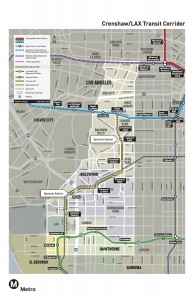The New York Times ran an article today discussing the challenges of bringing rail transit to Los Angeles International Airport (good ol’ LAX), and it features a quote from me about I why I think rail to the airport is more of a psychological victory than a ridership victory. Without further explanation, this quote may be confusing or controversial, so let me clarify.
Generally speaking, rail to airports is not the most desired mode of choice for travelers. If you’re lugging suitcases, and even worse if you’re traveling with small children, rail is logistically challenging and often quite stressful, especially before a big air trip. (Unfortunately I know this from experience, having traveled with all three of my young kids on long BART rides to SFO or via AirBART to Oakland.) It’s often cheaper, faster, and easier to drive and park at an economy, off-site lot.Meanwhile, wealthy travelers often prefer to take expensive cabs or luxury cars to the airport, and many other travelers have friends who can give them rides. In addition, super-shuttles are popular, as are some inexpensive bus connections (AC Transit to Oakland for example or the Santa Monica Big Blue or Culver City bus to LAX).
So right off the bat, rail to the airport is only going to appeal to a relatively small subset of passengers — probably the relatively less-affluent solo passengers.
Second, and more specific to Los Angeles, most travelers’ destinations and origins are so spread out across the metropolitan region that the likelihood of living, working, or recreating near an existing rail station to connect to LAX is not huge. Even worse, the spread-out nature of the urbanized city means that even if you did live, work, or recreate near rail, you would likely have to transfer a number of times to get to LAX, resulting in a trip that could often take hours and be fairly expensive, at least under the current fare structure. For example, if you lived in Pasadena, you would take the Gold Line to the Red Line to the Blue Line to the Green Line, which I’m guessing is about a two-hour trip.
By contrast, the flyaway shuttle from Union Station is cheap and convenient for those near or accessible to downtown LA. Travel modes like the shuttle are likely to get more usage than rail for far cheaper and without the big infrastructure build-out time and expense.
However, all is not doom and gloom when it comes to connecting LAX to rail. Here are some reasons for optimism: it will generate ridership, even if not the huge amount some might expect. In particular, airport employees will benefit as daily commuters. There will also be travelers for whom the Crenshaw line will provide quick service to their desired destinations (although that will probably be a small number of people). For example, in addition to destinations along the Crenshaw rail line, you could transfer from there to Santa Monica via a somewhat circuitous route or to downtown LA.
And more importantly, as Metro Rail gets fully built-out to reach major population, commercial and entertainment centers, the value of an airport connection will increase for both visitors and locals. The regional light rail connector through downtown will make possible a one-seat ride to Pasadena from LAX, eliminating the transfer mess I described above. A Crenshaw light rail connection to the Purple Line subway (not currently in the plans) could get travelers to Westwood, albeit circa 2037. And as I mention in the Times article, the psychological “branding” or image boost from rail to the airport will get Angelenos and visitors from around the world used to a new idea of an LA that is oriented around rail. More people will be curious about the system and may decide to ride it.
All good things.
But the point of my quote and perspective here is that rail enthusiasts should not overstate the importance of connecting the airport. It will be a slow, inconvenient journey for most people. Rather, advocates should focus on connecting high-density areas by rail and getting more high-density projects built around existing rail stations. Those advancements will benefit more people over the long-term than a rail-to-LAX project.
Leave a Reply
You must be logged in to post a comment.



